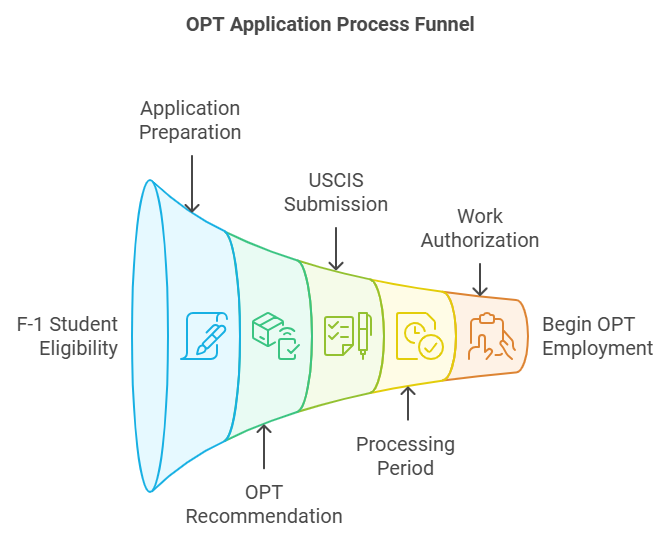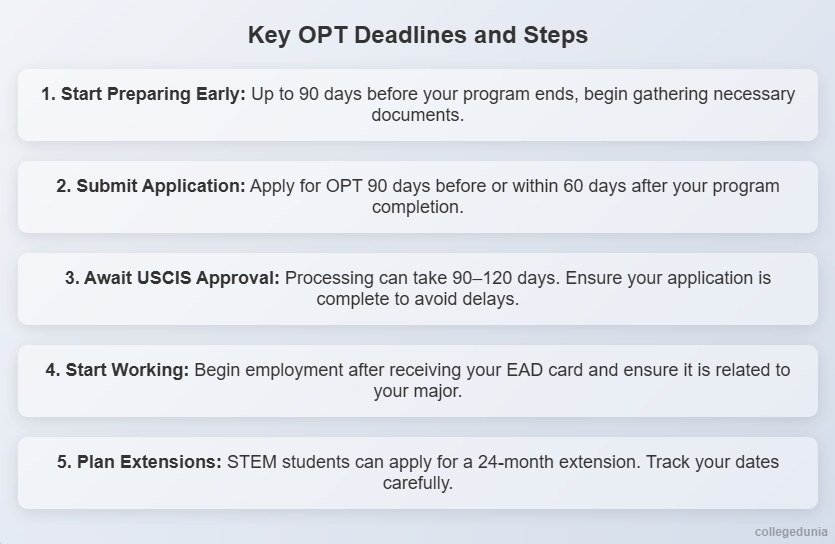.png?h=35&w=35&mode=stretch)
Yatin Kumar Study Abroad Content Specialist
Study Abroad Content Specialist
Optional Practical Training (OPT) is a critical pathway for F-1 international students in the U.S., enabling them to gain valuable hands-on experience in their field of study. With over 200,000 OPT approvals annually, it serves as a bridge between academic learning and professional success. OPT offers up to 12 months of work authorization (extendable by 24 months for eligible STEM students), allowing graduates to build industry connections, enhance their resumes, and secure a competitive edge in the global job market.
Whether you're aiming to transition to an H-1B visa, explore cutting-edge industries, or gain practical skills in your major, OPT is a gateway to career opportunities. However, understanding the application timelines, required documents, and employment criteria is essential to make the most of this opportunity.
Also Read: Student Guide to Study in USA
What is OPT?
Optional Practical Training (OPT) is a benefit available to F-1 students, allowing them to work in the U.S. in roles directly related to their academic major. Unlike a work visa, OPT is closely tied to the F-1 visa status and is available for up to 12 months per degree level, with additional extensions for eligible STEM students.
Key Highlights:
- Eligibility: F-1 students enrolled in a degree program who maintain valid visa status are eligible for OPT.
- Duration: Students can work up to 12 months under OPT, with a possible 24-month extension for STEM graduates.
- Application Timing: Applications can be submitted 90 days before program completion and up to 60 days after.
- Purpose: OPT helps students transition from academic training to professional employment in the U.S.
Also Read:
Eligibility and Types of OPT
Before diving into the details, it's essential to understand how OPT provides flexibility for international students, offering opportunities for professional growth while maintaining F-1 visa compliance. This section outlines who qualifies and the different OPT pathways available.
Eligibility for OPTTo qualify for OPT, students must:
|

Types of OPTOPT offers flexibility by catering to different stages of a student’s academic journey. Here’s a breakdown of the types of OPT and their unique features: Pre-Completion OPT:
Post-Completion OPT:
|
Deadlines and Application Process for OPT
Timing is everything when it comes to applying for OPT. Missing critical deadlines can result in delays or loss of eligibility, making it essential for students to plan and act early. This section breaks down when and how to apply for OPT.
When to Apply
- 90 Days Before Completion: Students can start the application process early to avoid delays.
- 60 Days After Completion: Applications must be submitted within this window to maintain eligibility.
Also Check: How to Appeal denied OPT Application
Application Process
Get OPT Recommendation on Form I-20:
- Obtain approval from the Designated School Official (DSO).
- The DSO will update the Student and Exchange Visitor Information System (SEVIS) with the OPT recommendation.
Submit Application to USCIS:
- File Form I-765 (Application for Employment Authorization) along with supporting documents and fees.
- Required documents include:
- Form I-20 with OPT recommendation.
- Copies of passport, visa, and I-94.
- Passport-sized photos.
- Personal check or money order for the filing fee.
| Processing Time: Typically takes 90–120 days. Planning ahead is critical to align work authorization with employment opportunities. |
Key Dates and Guidelines
Being aware of key dates is crucial for a successful OPT application. Missing deadlines or not adhering to guidelines can disrupt your plans and affect your work authorization.
- Start Date: OPT must begin within 60 days of completing the academic program.
- Duration: 12 months of OPT is available for each degree level.
- STEM Extension: STEM students can extend OPT by 24 months, bringing the total to 36 months.
- Reporting Requirements: Employment changes must be reported to the DSO to maintain status.

Common Challenges with OPT
While OPT offers numerous benefits, navigating the application process and work authorization requirements can present challenges for students. Here are some of the most common issues students face:
- Delays in Processing: Applications can take months to process, which may delay employment start dates.
- Job Market Competition: Securing employment within the field of study can be competitive.
- Transitioning to H-1B: Managing the transition from OPT to H-1B status requires careful planning to avoid gaps in work authorization.
- Maintaining Status: Working in unauthorized roles or failing to report employment can jeopardize F-1 status.
OPT provides an essential opportunity for F-1 students in the U.S. to gain practical experience, adding significant value to their academic achievements. However, navigating the application process, deadlines, and compliance requirements is essential to maximize the benefits and ensure a successful OPT experience. With careful planning and adherence to USCIS guidelines, students can make the most of their OPT period, setting a strong foundation for their professional careers in the U.S.
FAQs
Ques. Can students apply for OPT if they are outside the U.S.?
Ans. No, students must be physically present in the U.S. at the time of applying for OPT.
Ques. Is there any flexibility with the 12-month OPT duration?
Ans. The standard OPT period is 12 months per degree level. However, STEM students may qualify for an additional 24-month extension.
Ques. What happens if an OPT application is denied?
Ans. If denied, students may not reapply for OPT for that degree program. It’s essential to submit a complete and accurate application to avoid this outcome.
Ques. Can students change employers while on OPT?
Ans. Yes, students can change employers, but all employment must be in a field related to their major and should be reported to their DSO.
Ques. How many hours can students work during pre-completion OPT?
Ans. During the academic term, pre-completion OPT is limited to 20 hours per week. Full-time (up to 40 hours per week) is allowed during breaks or after program completion.
Ques. Can students travel internationally while their OPT application is pending?
Ans. Traveling while an OPT application is pending is generally not recommended, as re-entry may be challenging without an approved EAD card.






1720691033.png?tr=w-305,h-145,c-force?h=40&w=40&mode=stretch)






1715951259.png?tr=w-305,h-145,c-force?h=175&w=350&mode=stretch)




1690987543.png?tr=w-305,h-145,c-force?h=175&w=350&mode=stretch)





Comments